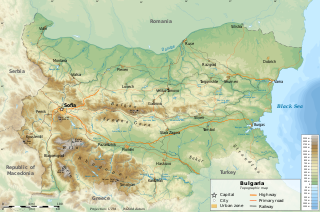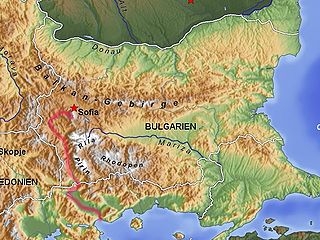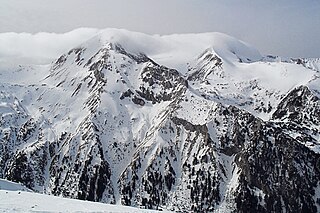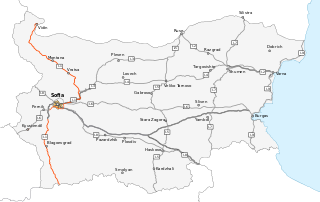
Bulgaria is a country situated in Southeast Europe that occupies the eastern quarter of the Balkan peninsula, being the largest country within its geographic boundaries. It borders Romania to the north, Serbia and North Macedonia to the west, Greece and Turkey to the south, and the Black Sea to the east. The northern border with Romania follows the river Danube until the city of Silistra. The land area of Bulgaria is 110,994 square kilometres (42,855 sq mi), slightly larger than that of Cuba, Iceland or the U.S. state of Tennessee. Considering its relatively compact territorial size and shape, Bulgaria has a great variety of topographical features. Even within small parts of the country, the land may be divided into plains, plateaus, hills, mountains, basins, gorges, and deep river valleys. The geographic center of Bulgaria is located in Uzana.

The Struma or Strymónas is a river in Bulgaria and Greece. Its ancient name was Strymṓn. Its drainage area is 17,330 km2 (6,690 sq mi), of which 8,670 km2 (3,350 sq mi) in Bulgaria, 6,295 km2 (2,431 sq mi) in Greece and the remaining 2,365 km2 (913 sq mi) in North Macedonia and Serbia. It takes its source from the Vitosha Mountain in Bulgaria, runs first westward, then southward, forming a number of gorges, enters Greece near the village of Promachonas in eastern Macedonia. In Greece it is the main waterway feeding and exiting from Lake Kerkini, a significant centre for migratory wildfowl. Also in Greece, the river entirely flows in the Serres regional unit into the Strymonian Gulf in Aegean Sea, near Amphipolis. The river's length is 415 kilometres (of which 290 kilometres in Bulgaria, making it the country's fifth-longest and one of the longest rivers that run solely in the interior of the Balkans.

Blagoevgrad Province, also known as Pirin Macedonia or Bulgarian Macedonia, is a province (oblast) of southwestern Bulgaria. It borders four other Bulgarian provinces to the north and east, the Greek region of Macedonia to the south, and North Macedonia to the west. The province has 14 municipalities with 12 towns. Its principal city is Blagoevgrad, while other significant towns include Bansko, Gotse Delchev, Melnik, Petrich, Razlog, Sandanski, and Simitli.

The Pirin Mountains are a mountain range in southwestern Bulgaria, with the highest peak, Vihren, at an altitude of 2,914 m (9,560 ft).

Simitli also known as Simitliya, is a town in Blagoevgrad Province in southwestern Bulgaria. It has a population of 7,454 and is located 17 km south of Blagoevgrad. It is the seat of Simitli Municipality.

Pirin National Park, originally named Vihren National Park, encompasses the larger part of the Pirin Mountains in southwestern Bulgaria, spanning an area of 403.56 square kilometers (155.82 sq mi).

European route E 79 is a road part of the International E-road network. It begins in Miskolc, Hungary and ends in Thessaloniki, Greece, also running through Romania and Bulgaria. The road is 1,300 km (810 mi) long.

The Struma Motorway is a motorway currently under construction in Bulgaria. The motorway is located in the Yugozapaden area in South West Bulgaria, and follows the route Sofia-Pernik-Dupnitsa-Blagoevgrad-Sandanski to Kulata on the border with in Greece. It is part of the Pan-European Corridor IV and also is part of Е79, that runs from Miskolc (Hungary) to Thessaloniki (Greece), via the Romanian cities of Deva and Craiova. This project is under the European Union's Ten-T Priority Projects. The road is also part of the proposed Via Carpatia route.

Kresna is a town and the seat of Kresna Municipality in Blagoevgrad Province in Bulgaria.

Highways in Bulgaria are dual carriageways, grade separated with controlled-access, designed for high speeds. In 2012, legislation amendments defined two types of highways: motorways and expressways. The main differences are that motorways have emergency lanes and the maximum allowed speed limit is 140 km/h (87 mph), while expressways do not and the speed limit is 120 km/h (75 mph). As of October 2023, a total of 879,1 kilometers of motorways are in service.

The Corridor IV is one of the Pan-European transport corridors. It runs between Dresden/Nuremberg in Germany and Thessaloniki (Greece) / Constanța (Romania) / Istanbul (Turkey). The corridor follows the route: Dresden / Nuremberg – Prague – Vienna – Bratislava – Győr – Budapest – Arad – Bucharest – Constanța / Craiova – Sofia – Pernik - Thessaloniki or Plovdiv – Istanbul.
Kresna Gorge Tunnel was a planned twin-tube tunnel in Blagoevgrad Province, Bulgaria. The tunnel would be part of Struma motorway (A3), that runs between Sofia and the border crossing to Greece, at the village of Kulata.

Republic road I-1 is a major road in western Bulgaria. It runs between the New Europe Bridge, at the Danube border with Romania, and the village of Kulata, at the border crossing to Greece. The total length of the road is 453.8 km (282.0 mi). Most of it provides one driving lane per direction and it is planned to be superseded or replaced in all sections by either motorways, or expressways.

Stara Reka is one of the nine nature reserves in the Central Balkan National Park in central Bulgaria. Stara Reka was established on 19 March 1981 to protect the unique ecosystems of the Balkan Mountains. It spans an area of 1974.7 hectares, or 19.747km2.
CEE Bankwatch Network is a global network which operates in central and eastern Europe. There are 17 member groups, multiple non-governmental organizations based in different locations; the network is one of the largest networks of environmental NGOs in central and eastern Europe. Bankwatch's headquarters rest in Prague, Czech Republic.

Tisata is a nature reserve in south-western Bulgaria. It is situated in Kresna Municipality, Blagoevgrad Province. The reserve is managed by the administration of Pirin National Park despite the fact it lies outside the limits of the park.

The Melnik Earth Pyramids are rock formations, known as hoodoos, situated at the foothills of the Pirin mountain range in south-western Bulgaria. They span an area of 17 km2 near the town of Melnik, Blagoevgrad Province. Reaching a height of up to 100 m these sandstone pyramids are shaped in forms, resembling giant mushrooms, ancient towers and obelisks. They were formed primarily due to erosion from rainfall and bedrock wear. The Melnik Earth Pyramids are a geological phenomenon of global importance and were declared a natural landmark in 1960. The rock formations are home to rich flora and fauna heavily influenced by the Mediterranean climate. They are a tourist destination due to the natural environment of the area, the cultural sights of Melnik and the Rozhen Monastery.

The Crete Mediterranean forests is a terrestrial ecoregion that encompasses the Greek island of Crete.

Sandanski–Petrich Valley is situated in southwestern Bulgaria along the river Struma and its right tributary Strumeshnitsa, with a very small part of the territory extending to Greece. The valley is enclosed by several mountain ranges, three of them reaching heights of over 2,000 m, and is open to the Strumitsa Valley to the west and the Serres Valley to the south. Due to the proximity to the Aegean Sea, the climate is continental Mediterranean, making Sandanski–Petrich Valley one of the warmest regions of Bulgaria.

The Zheleznitsa Tunnel is a 2-kilometre (1.2 mi) highway twin tunnel on the Struma motorway in Blagoevgrad Province, southwestern Bulgaria. It is the longest road tunnel in Bulgaria. The tunnel is named after the village of Zheleznitsa, which it bypasses between the towns of Blagoevgrad and Simitli.




















